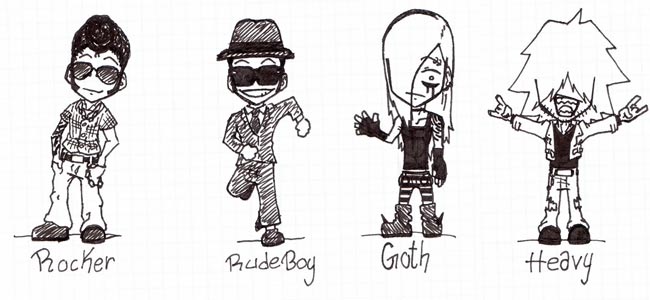It is difficult to make a complete list of subcultures. Subcultures are live sociological phenomena, they are phenomena that change over time and depends on the location, state and continent where occur. Also, changes that occur in society and the mainstream culture, leads to the emergence of new subcultures, whereas the old disappear or change. So subcultures list must include a subcultures that no longer exist, some of which are in the process of disappearance and subcultures that are arising. Best way to better understand the term and concept is to look at the individual subcultures. Here you can find a complete list of subcultures with accompanying texts for each. This subcultures list contains more than 50 subcultures linked to proper articles.
List of subcultures in alphabetic order
A: Anarcho-punk, Anarcho-syndicalism
B: BDMS, Beatniks, Bikers, Bills, Bohemianism, Bodybuilding, Bōsōzoku
C: Casuals, Cosplayers, Cybergoth
D: Dark Culture, Deaf Culture, Demoscene, Diesel Boys (Dizelasi)
E: Emo
F: Fandom, Fetish subculture, Flogger, Freak scene, Furries
G: Gamer, Goth, Gothic Lolita, Gopniki, Graffiti writers, Greaser, Grebo, Grungies, Glam rock
H: Hacker culture, Hardline, Hiphop, Hippie, Hipster
I: Industrial
J: Juggling, Juggalo, Junglist
L: Lager Lout, Leather culture, LGBT (bears, gay)
M: Mods, Metalheads
N: NS Black Metal, Nazi punks, New Age, New Age Travellers, New Romaniticism, Norwegian black metal, Nudism/Naturism
O: Otaku, Otherkin
P: Patchuco, Pokémon, Preppy, Punks
Q: Queer
R: Raggare, Rave, Riot Grrrl, Rivethead, Rockabilly, Rocker, Role-playing gamers, Rude boys
S: Sapeurs, Scooterboys, Skater, Skinheads (Red skin, Trojan skin, White power skin), Soulboys, Straight edge, Suadehead, Sukeban, Surfers, Swing kids, Swinging
T: Teenybobbers, Teddyboys, Trekkies
Z: Zazou
Subcultures theoretical overview
“Subculture is used to designate both the traditional norms of a sub-society and the emergent norms of a group caught in a frustrating and conflict-laden situation.” Milton Yinger’s quote is just one of many attempts to define the term and concept of subculture. It is hard to define subculture in one basic widely accepted definition. Here you can find some most common of many subculture definitions.
The term has been used by anthropologists and sociologists in variety of ways and contexts, it contains much ambiguity. But, the widely accepted and used (not the only) meaning of term is: “A group of people with a culture which differentiates them from the dominant (mainstream, traditional) culture in a society to which they belong”.
The sociologist (anthropologists, philosophers) uses the term without a value judgment. Most influential studies of subcultures originate from Chicago School of Sociology and Birmingham University’s Centre for Contemporary Cultural Studies (CCCS). Here you can find more about subculture theory (Subcultural theory of Chicago School of Sociology and CCCS) also here you can find more on Subculture Birmingham theory. Probably the most influential book in this field is Hebdige’s Subculture: The meaning of style. Richard “Dick” Hebdige is an expatriate British sociologist most commonly associated with the study of youth cultures (also associated with Birmingham University’s CCCS). Good examples of books related to the subcultures and that apply to the description of individual youth culture (skinheads) with little emphasis on subcultural theory are: “Spirit of 69 – A skinhead bible” and “Nick Knight skinhead”.
Also a good way is to consider specific examples that best reflect the specific types of subcultures, for example – music subcultures.
In 1985 French sociologist Michel Maffesoli coined the term urban tribe, and it gained widespread use after the publication of his “The Time of the Tribes”. Also recently the term scene is used as another synonym of subculture primarily for a youth-based cultures.

